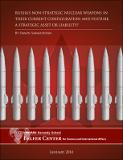| dc.contributor.author | Saradzhyan, Simon | |
| dc.date.accessioned | 2016-01-26T16:35:34Z | |
| dc.date.issued | 2010 | |
| dc.identifier | Quick submit: 2016-01-12T12:18:43-05:00 | |
| dc.identifier.citation | Saradzhyan, Simon. 2010. Russia’s Non-strategic Nuclear Weapons in Their Current Configuration and Posture: A Strategic Asset or Liability? Cambridge, MA: Belfer Center for Science and International Affairs, Harvard University. | en_US |
| dc.identifier.uri | http://nrs.harvard.edu/urn-3:HUL.InstRepos:24890952 | |
| dc.description.abstract | Russia's military-political leadership envisions a formidable range of uses for the country's arsenal of non-strategic nuclear weapons (NSNWs). In the eyes of Russian leaders, these weapons play a critical role in the nation's defense and security posture as part of the country's overall nuclear arsenal and as an equalizer for the weakness of the nation's conventional forces vis-a-vis NATO and China. Russia's military-political leadership and policy influentials also assign a number of specific roles to NSNWs, including deterrence of powers in the south.
Given these perceived and real benefits of possessing NSNWs, it is rather difficult to imagine that Russia will agree to eliminate all of its non-strategic nuclear weapons in the foreseeable future even if its actions are fully reciprocated by the U.S. and other nuclear weapons states. However, securing Russia's consent to negotiate an arms control treaty that would reduce the numbers of non-strategic nuclear weapons and put them under accounting and verification regimes is not a mission impossible.
First, only some of the roles envisioned for these weapons are realistic, and these roles require far fewer NSNWs than what Russia has today. Second, the Russian leadership's perceptions of NSNWs' roles can change too. In fact, Russia has already either indicated or explicitly stated conditions that if met, would facilitate Moscow's consent to verifiable reductions of Russian and U.S. NSNWs, which are now subject only to unilateral U.S. and Russian presidential initiatives, which are unverifiable and non-binding. There are also a number of other factors that can help lower the value of NSNWs in the eyes of the Russian military-political leadership.
Third, while there are perceived benefits of possessing tactical nuclear weapons, there are also formidable risks and costs incurred by Russia's current NSNW posture.
I would argue that a Russian-U.S. arms control treaty with verification and accounting mechanisms would be a good first step to both reducing these risks and costs and to bringing the numbers of NSNWs down to levels sufficient for the roles that these weapons can realistically play. | en_US |
| dc.language.iso | en_US | en_US |
| dc.publisher | Belfer Center for Science and International Affairs, Harvard University | en_US |
| dc.relation.isversionof | http://belfercenter.ksg.harvard.edu/publication/19940/russias_nonstrategic_nuclear_weapons_in_their_current_configuration_and_posture.html | en_US |
| dash.license | LAA | |
| dc.title | Russia’s Non-strategic Nuclear Weapons in Their Current Configuration and Posture: A Strategic Asset or Liability? | en_US |
| dc.type | Research Paper or Report | en_US |
| dc.date.updated | 2016-01-12T17:18:45Z | |
| dc.description.version | Version of Record | en_US |
| dc.rights.holder | Simon Saradzhyan | |
| dash.depositing.author | Saradzhyan, Simon | |
| dc.date.available | 2016-01-26T16:35:34Z | |
| dash.contributor.affiliated | Saradzhyan, Simon | |


